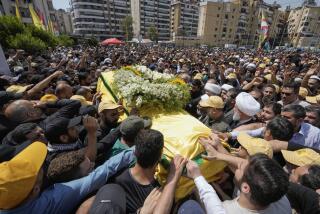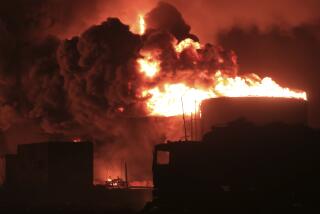Twin Strikes Carry Marks of Al Qaeda
LONDON — The place, style and timing of twin terror attacks on Israelis in Kenya on Thursday are signatures with the handwriting of a prime suspect: the Al Qaeda network.
Law enforcement officials and counter-terrorism experts in Europe, the United States and Israel said it was too soon to conclude that the bombing of a resort near Mombasa that caters to Israelis and the simultaneous missile attack on an Israeli charter flight taking off nearby were definitely the work of Osama bin Laden’s organization.
A few experts thought Palestinian groups or Hezbollah, which has a history of hitting Israeli targets around the world, might have been involved.
But overall, veterans of the fight against Al Qaeda saw the carnage in Kenya as part of the resurgent terror network’s widening war against the West. In a global counterattack since the U.S. invasion of Afghanistan, an increasingly decentralized Al Qaeda has expanded beyond its once exclusive focus on U.S. targets to single out American allies with bombings from Pakistan to Tunisia to the Indonesian island of Bali.
The terror network has accompanied the mayhem with unusually specific threats against countries that include Australia, Germany, Italy -- and Israel.
“The preferred target is still the U.S., but it’s harder to hit the U.S. now,” said Jonathan Stevenson of the International Institute for Strategic Studies in London. “They have become more flexible. They will hit soft European targets and any Western Christian, and now any Israeli, will do. They want to hit civilians and anyone they see as inimical to Islam.”
If Al Qaeda is to blame for Thursday’s attacks, the organization appears to have opened an ominous new front in its campaign to rally the Muslim world to its cause, experts said. After years of verbal violence against Jews and Israel, they said, Bin Laden’s forces spilled Israeli blood at a moment of maximum Middle East tension.
The apparent intent: to push Israel into a more prominent role in the U.S.-led war on terror and trigger a backlash among Muslims already incited by the Israeli-Palestinian conflict and the U.S. confrontation with Iraq.
“They want to unify the Arab nationalist struggle by identifying with the Palestinian cause,” said Roland Jacquard, a French counter-terrorism consultant and author of the recent book “The Secret Archives of Al Qaeda.” “If you draw Israel into the war on terror, you pour fuel on the fire. They have done it at the moment of a possible war with Iraq because they want to unify all Arabs.”
In videotaped and written communiques, Bin Laden has heaped abuse on Israel and claimed solidarity with Palestinians. Al Qaeda’s simultaneous 1998 bombings of U.S. embassies in Kenya and Tanzania were carried out in the name of a front organization dedicated to killing “Crusaders [Christians] and Jews.”
And in a symbolically charged act that was allegedly coordinated by Al Qaeda’s military chief in Pakistan, Khalid Sheik Mohammed, via satellite phone, a suicide truck bomber killed French and German tourists outside a historic synagogue on the Tunisian island of Djerba in April.
The decision to hit Israelis was probably made by a high-ranking figure, according to Jacquard. That may have been the next logical step in an evolving military and political strategy, according to Daniel Benjamin, a former National Security Council counter-terrorism official and coauthor of “The Age of Sacred Terror.”
“There’s a sense the group is refocusing on Israeli and Jewish targets,” Benjamin said. “Al Qaeda has been trying to increase its profile in the Middle East and to establish a foothold in the Arab-Israeli conflict, and this would certainly help it achieve that goal.”
The circumstantial evidence suggests Al Qaeda involvement, according to Benjamin and others. As the 1998 embassy bombings made clear, the network has had an entrenched infrastructure in Kenya, specifically in the Mombasa area.
Moreover, the precision and choreography of the simultaneous strikes recall the Sept. 11 hijackings as well as the African embassy bombings. In an additional wrinkle, the terrorists used different weapons on distinct groups of Israeli tourists, one that had just arrived at the Mombasa beach resort and another that was departing by air.
“The use of synchronized attacks using different modes in one operation is a classic hallmark of Al Qaeda,” Benjamin said.
As in Tunisia and the bombing of a Bali nightclub last month, in which investigators allege an Al Qaeda connection, the intended human casualties were tourists, with a secondary economic target: the tourist industry. This reflects Al Qaeda’s adjustment to a post-Sept. 11 reality in which it is weaker, yet more elusive, the experts said.
The U.S. military and law enforcement campaign against terrorism has wiped out Al Qaeda’s sanctuary in Afghanistan, left a number of its leaders dead or captured and disrupted its operations and finances. The terrorists have been forced away from preferred targets such as U.S. embassies and bases, which have built up their defenses.
“If it is Al Qaeda, it is paradoxically a reflection of the success we’re having in our struggle against them,” said Bruce Hoffman of the Rand Corp. “This may be demonstrating that the targets they would most like to get are too difficult for them to hit. The tragedy, of course, is that they’re merely shifting their attention to more accessible and softer targets, with extremely tragic consequences.”
Because Al Qaeda was always a loose alliance of networks with limited hierarchy and considerable autonomy, it has survived through metamorphosis, taking refuge in more than 60 countries and counterattacking on multiple battlefields.
“They want to show they have no limits, no borders,” an Italian counter-terrorism investigator said. “That they can hit anywhere. The message is that they have reorganized and they are going to carry out the threats they have made.”
Nonetheless, Al Qaeda is not the only possible culprit in the Kenya case. Lebanon-based Hezbollah has a history of sophisticated terrorist acts against Jewish targets outside Israel. Hezbollah operatives, supervised and financed by Iranian intelligence agents, allegedly committed two attacks in Argentina, according to authorities: the 1992 bombing of the Israeli Embassy that killed 29 people and the bombing of a Jewish community center two years later that killed 85.
The choice of exclusively Israeli targets is consistent with Hezbollah, according to Vince Cannistraro, a former counterterrorism official at the CIA. So was the quick claim of responsibility from an unknown group calling itself the Army of Palestine, he said, because Hezbollah often invents groups to take credit for attacks.
“I would be very cautious in ascribing this to Al Qaeda,” Cannistraro said. “Hezbollah really invented suicide bombings, not Al Qaeda.”
Palestinian terrorists also are potential culprits. Cannistraro said the Israeli clampdown on the Palestinian territories has reduced terrorists’ ability to smuggle in weapons and carry out attacks in the region. As a result, he said, Palestinian militants may have turned to overseas targets, reviving a practice that was common 20 years ago.
“What this signals is that we’re back to the worldwide attacks that we saw on Israelis in the 1970s,” Cannistraro said. Striking a beach hotel in Kenya is far easier than hitting an Israeli embassy, Cannistraro said. “There are not a lot of soft Israeli targets around the world.”
As Islamic terrorist organizations find common cause in the post-Sept. 11 battlefield, there is another troublesome scenario, according to Jacquard. Hezbollah and Al Qaeda could have teamed up to strike Israel. Investigations have revealed contacts and cooperation between the two organizations, he said.
Both have Russian SA-7 Strella missiles of the type believed to have been fired Thursday at the Boeing 757 operated by Arkia, an Israeli charter airline, according to experts.
The use of the missiles revives a longtime nightmare for law enforcement. While large airports, particularly those in capitals, usually have secure perimeters, there are probably hundreds of airports in smaller cities and tourist destinations that have little in the way of perimeter security.
That matters because it is difficult to hit a plane with a shoulder-fired missile once it is in the air, but planes are most vulnerable while still on the runway or just taking off, experts said.
“The issue of missiles is a complex and intricate threat,” said Israel Borovich, the president and chief executive officer of Arkia. “It is definitely taken into consideration by the security services
The Mombasa airport may have been hit because planes tend to fly low after taking off over the seashore, gaining altitude more gradually than in other airports.
“It’s not an accident that Mombasa was chosen for such an attack,” said Eitan Ben-Eliyahu, a former major general and chief of the Israeli air force. “After takeoff, planes fly low there, which makes a strike easier. Had one of the missiles hit the plane, it would have been very bad.”
The bloodshed on the beach, then, only reinforces the fear felt by Americans, Europeans, Israelis and other Westerners just about anywhere. The rhythm of the violence has not faltered; it seems likely to speed up, according to some experts.
“I think the closer we get to war [with Iraq], there’s going to be more and more attacks,” said Robert Baer, a former CIA officer with extensive Middle East experience.
And because the always shadowy Al Qaeda has gone further underground, police and intelligence agencies continue to wrestle with a high-stakes question: Is this wide-ranging flurry of small and medium-sized attacks the most the organization can muster? Or is the offensive designed to keep the West off-balance while terrorists prepare a large-scale plot comparable to the Sept. 11 attacks?
“The rhythm is very worrisome,” Jacquard said. “You had the same kind of situation before Sept. 11. You had groups with autonomy doing operations in different places that occupied and distracted the authorities while an elite group prepared the big attack.”
*
Rotella reported from London and Vieth from Washington. Times staff writers Alissa J. Rubin in Jerusalem and Greg Miller in Washington contributed to this report.
More to Read
Sign up for Essential California
The most important California stories and recommendations in your inbox every morning.
You may occasionally receive promotional content from the Los Angeles Times.










